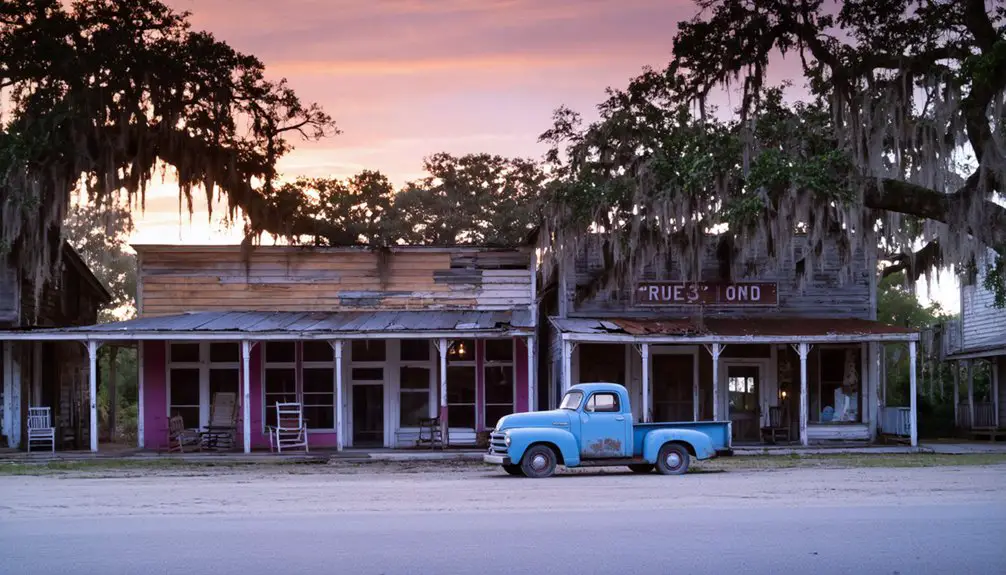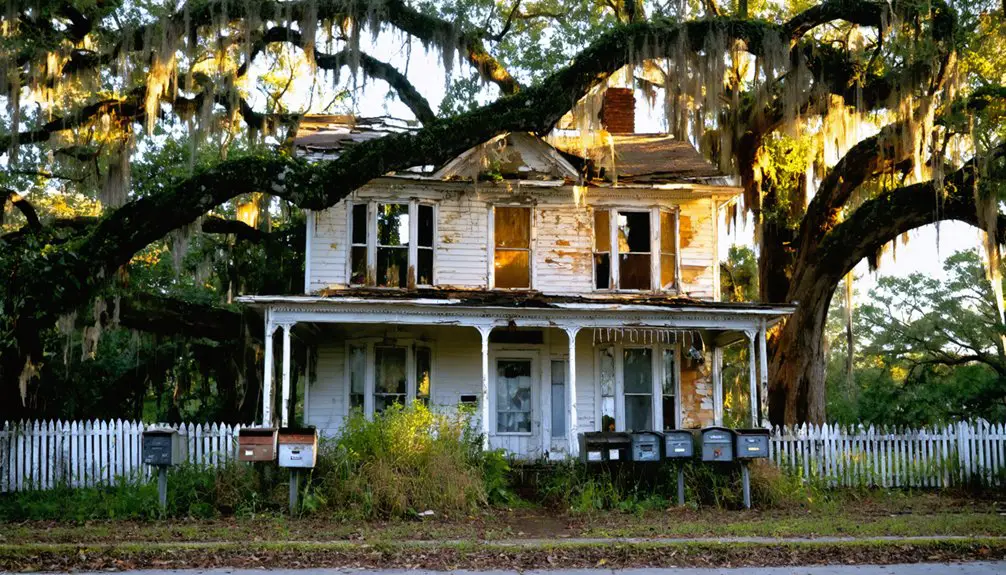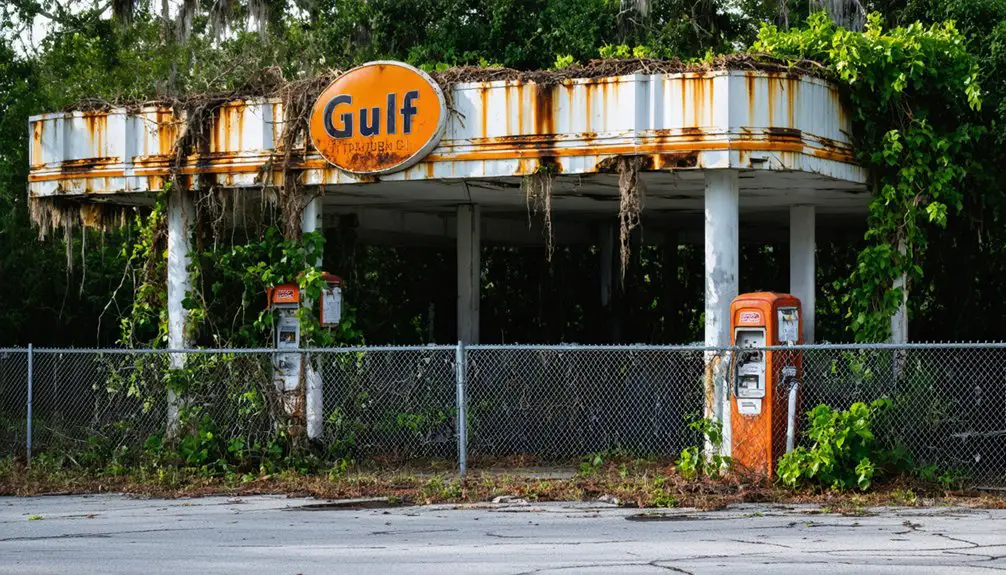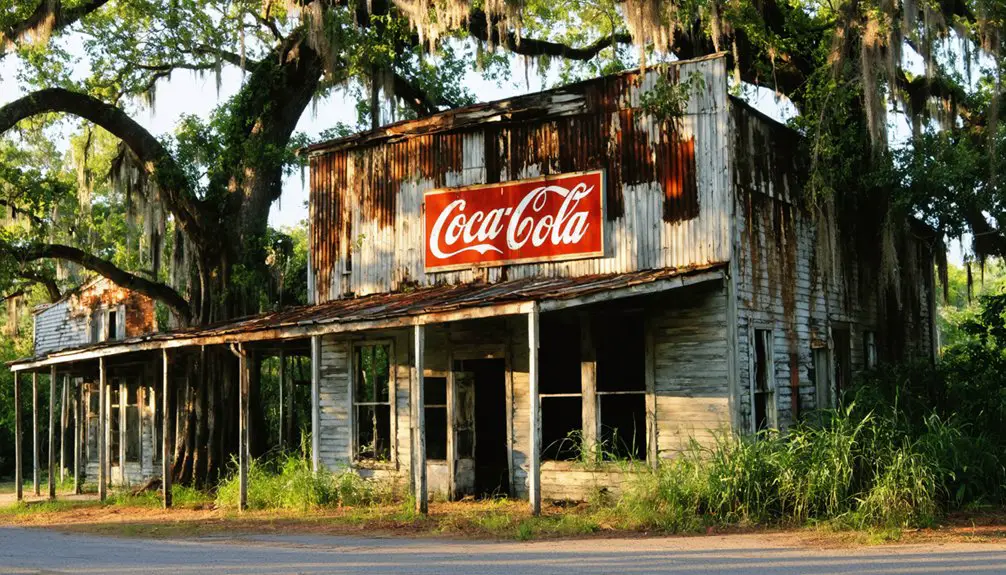You’ll find Oakgrove’s ghost town ruins in Hernando County, Florida, where a bustling lumber and turpentine community thrived in the early 1900s. The town’s economic backbone consisted of longleaf pine harvesting, railroad operations, and turpentine production, employing both white and Black workers. When the timber resources were depleted and industries collapsed, residents abandoned the settlement. Today, crumbling brick foundations and rusted metal remnants tell a deeper story of Florida’s industrial past.
Key Takeaways
- Oakgrove transformed from a thriving early 1900s railroad and timber town to a ghost town after the collapse of logging industries.
- The town’s economy relied heavily on logging and turpentine production until resources were depleted, leading to mass exodus.
- Railroad infrastructure and industrial operations were abandoned when sawmills closed and pine forests were exhausted.
- Physical remnants include rusted metal, crumbling brick foundations, and abandoned rail lines from the early 1900s industrial era.
- Annual Oak Grove Homecoming events preserve community memory while archaeological findings document the town’s historical significance.
Early Days and Settlement History
As Florida’s timber and railroad industries expanded in the early 1900s, the small community of Oakgrove emerged in Hernando County.
You’ll find that early settlers faced typical frontier challenges while establishing their homes and farms in this bustling railroad town. They acquired land through homesteading, built permanent structures, and cultivated crops alongside their industrial work.
The settler experience in Oakgrove wasn’t isolated – the community maintained strong connections with neighboring towns like Centralia, sharing labor forces and social ties. Like the Norwegian immigrants who developed Viking, Florida, these pioneers worked to establish productive agricultural enterprises.
The town developed a significant Black workforce that was crucial to agricultural and industrial operations in the region.
Families established essential institutions, including schools and gathering places, creating a tight-knit community despite the hardships of early Florida life.
The town’s strategic location near railroad lines proved vital for its development, allowing residents to participate in the region’s growing timber and turpentine industries.
Economic Rise Through Logging and Turpentine
While Oakgrove’s early settlers established their homesteads, the town’s economic engine roared to life through its bustling logging and turpentine industries. You’d have found vast stretches of longleaf yellow pine and cypress being harvested since British Colonial times, with timber floating downriver or moving by rail on the Green Cove Springs & Melrose Railroad by 1881. By 1929, two forestry associations emerged to promote replanting efforts and protect the area’s valuable timber resources.
The town’s prosperity hinged on maximizing its forest resources. After loggers cleared prime timber, workers extracted valuable pine resin for turpentine production. Workers collected the sap using hurdy cups attached to trees. This dual-industry approach created jobs and attracted workers to Oakgrove’s growing economy.
Life in a Working-Class Railroad Town
You’ll find railroad workers in Oakgrove spent grueling days maintaining tracks, loading cargo, and operating machinery alongside their counterparts in the logging and turpentine industries.
Their shared experiences of physical labor and workplace hazards forged strong community bonds, with workers often supporting each other through economic uncertainties and industrial accidents. Before the Civil War, the town flourished as part of the 156-mile line connecting Fernandina to Cedar Key.
The railroad’s constant presence shaped every aspect of daily life, from the timing of shifts to the rhythm of commerce, as trains brought essential supplies and transported the region’s timber and turpentine products to market. Much like Fort White’s history, the town experienced a dramatic population decline when mining and agricultural industries faded away.
Railroad Workers’ Daily Lives
Life in Oakgrove’s railroad community during the early 1900s revolved around demanding physical labor and close-knit social bonds.
You’d start your day at dawn, heading to work alongside fellow laborers to operate railroad machinery, load lumber, or maintain tracks. The Florida heat and humidity would bear down on you as you tackled the physical demands of freight transport and mill operations. The Suwannee River Route connected the region’s bustling timber industry to vital transportation networks.
After your dawn-to-dusk shift, you’d return to your modest wooden home, situated within walking distance of the railroad.
Your evenings and weekends would find you at community gatherings in local churches or general stores, where you’d share stories with neighbors who understood the challenges of railroad work.
Despite the occupational hazards and seasonal employment uncertainty, you’d find strength in the tight-knit working-class community that called Oakgrove home.
Industry Shaped Community Bonds
Through shared experiences of grueling labor and economic uncertainty, Oakgrove’s industrial workers forged unshakeable community bonds in the early 1900s.
You’d find workers supporting each other in logging camps, turpentine operations, and railroad yards, where dangerous conditions demanded trust and cooperation. Their community resilience showed in the way they’d gather after long shifts, sharing meals and stories in company towns and worker camps. Similar to the success at Ellaville Mill, many sawmills in Oakgrove employed hundreds of workers who formed tight-knit communities.
Labor solidarity emerged naturally as families faced the boom-and-bust cycles together.
African-American neighborhoods contributed essential cultural dimensions while fostering distinct support networks. When you walked through Oakgrove then, you’d witness how shared challenges in the timber and turpentine industries created lasting connections.
The railroad’s presence strengthened these bonds further, linking workers’ lives through commerce and social exchange.
Industrial Infrastructure and Development
You’ll find evidence of Oakgrove’s industrial might in the railroad infrastructure that once connected it to neighboring timber towns like Centralia.
The town’s economic foundation rested on an intricate network of rail lines and tram roads that transported lumber and turpentine products along Lafayette Creek to larger markets. The operation was similar in scale to Old Muskogee, which ran five locomotives and 70 rail cars. Like the prosperous Ellaville sawmill that employed 500 workers, Oakgrove’s operations drove significant economic growth in the region.
Physical remnants, including scattered brick foundations and archaeological features like cattle dip vats, offer tangible proof of the town’s industrial operations from the early 1900s.
Railroad Impact Analysis
As Florida’s railroad infrastructure expanded in the late 19th century, Oakgrove’s economic landscape underwent dramatic transformation driven by Henry Flagler’s Florida East Coast Railway and the Atlantic Coast Line Railroad.
You’ll find that railroad expansion catalyzed unprecedented agricultural development, with new rail lines enabling farmers to transport perishable crops to broader markets.
The region’s growth mirrored the statewide pattern where railroads earned 8,000 acres per mile constructed through land-grant laws.
This strategic development connected Oakgrove to major freight yards and maintenance facilities, considerably lowering shipping costs for local agricultural businesses.
The integration of short line railroads, later absorbed by mainlines, demonstrated how agricultural demands shaped rail infrastructure development, transforming isolated communities into vibrant economic centers through reliable mass transportation networks.
Industrial Building Remnants
Rusted metal and crumbling brick foundations scatter Oakgrove’s landscape, marking the remnants of its once-bustling industrial sector from the early 1900s.
You’ll find evidence of the town’s economic backbone in the brick and masonry ruins that housed logging operations and turpentine processing facilities. The industrial architecture reflects the era’s construction methods, with durable brick structures that have partially withstood time’s passage.
Throughout the forest clearings, you can spot foundation patterns revealing where warehouses and small factories once stood.
While most buildings have deteriorated to their basic elements, the brick preservation varies – some sites retain partial walls while others exist only as scattered fragments.
Metal artifacts and Herty cups discovered nearby hint at the processing equipment that once powered Oakgrove’s industrial activities.
Community Demographics and Social Structure

While detailed records remain sparse, Oak Grove’s early 1900s community centered around Florida’s logging and turpentine industries, with a small but close-knit population of mill workers and laborers.
The town’s strong community heritage lives on through:
Strong community bonds endure, keeping Oak Grove’s heritage alive through generations of shared traditions and collective memory.
- Annual Oak Grove Homecoming events, ongoing for over 50 years
- Active cemetery preservation efforts by descendants of original families
- Multi-generational social networks that maintain familial connections
You’ll find evidence of Scandinavian and Scottish ancestry among the residents, reflecting the broader European heritage of Florida’s ghost towns.
The social fabric was woven through shared worker housing, church gatherings, and educational institutions.
Despite the town’s eventual decline, descendants continue preserving their cultural legacy through regular gatherings and oral history transmission.
Connecting Lines: Railways and Trade Routes
Through the crisscrossing veins of Florida’s early railway system, Oakgrove found its economic lifeline in the Florida Railroad‘s strategic 5 ft gauge line.
You’ll find evidence of these railway connections in the railroad spikes and coal pieces that still dot the landscape today, marking where steam locomotives once thundered past.
These crucial arteries shortened cargo routes by 800 miles, connecting Gulf and Atlantic ports while bypassing treacherous southern waters.
You can trace Oakgrove’s trade expansion through the remnants of turpentine production – hurdy cups on pine trees – and logging roads that facilitated resource transportation.
The rail system integrated Oakgrove into a broader economic network, linking towns like Callahan, Baldwin, and Waldo, while enabling local African American communities to participate in lumber and agricultural commerce.
The Decline and Abandonment

As Oakgrove’s essential resources dwindled in the early 20th century, the town’s fate became increasingly clear.
The community’s economic vulnerability stemmed from its heavy dependence on lumber and turpentine industries, which proved unsustainable once the surrounding forests were depleted.
You’ll find three major factors that accelerated Oakgrove’s demise:
- The closure of the sawmill following cypress tree exhaustion, eliminating primary employment
- The collapse of the turpentine industry after pine trees were overharvested
- The subsequent exodus of workers and families seeking opportunities elsewhere
This mass departure led to severe community fragmentation.
Without a stable population, public services ceased, and buildings fell into disrepair.
Florida’s harsh climate hastened the decay of wooden structures, while nature gradually reclaimed the abandoned town site.
Physical Remnants and Archaeological Findings
Modern archaeological investigations have revealed significant physical evidence of Oakgrove’s former existence. You’ll find brick foundations and remnants scattered throughout the wooded areas near old railroad lines, showcasing the town’s architectural footprint.
The archaeological significance of the site is demonstrated through over 1,900 recovered artifacts, including ceramics, bottles, and metal items that paint a picture of daily life.
The rich collection of nearly 2,000 artifacts reveals intimate details of everyday existence in this vanished settlement.
The artifact analysis has uncovered herdy cups used in turpentine collection, pointing to the area’s industrial past. Railroad spikes and coal fragments suggest active rail transport supported local commerce.
While exploring the site, you’ll notice how nature has reclaimed the land, with pine and redwood trees growing alongside structural remains, creating a haunting reminder of this once-thriving community.
Environmental Changes and Natural Reclamation

While Oakgrove’s buildings have long since vanished, dramatic environmental changes continue to reshape the abandoned townsite.
You’ll find evidence of both natural reclamation and industrial impacts, particularly around former mining operations where groundwater contamination persists. Saltwater intrusion from rising seas has accelerated ecological succession, transforming nearby forests into ghostly stands of dead trees.
The area’s transformation includes three major changes:
- Former phosphate mines have undergone partial natural revegetation, though contamination still affects local hydrology.
- Coastal forests have converted to salt marshes, creating new wetland ecosystems that help buffer storm surges.
- Groundwater pollution from industrial waste requires ongoing treatment, including air strippers to remove TCE from wells.
These environmental shifts reflect nature’s resilience, even as human impacts continue shaping the landscape.
Legacy and Historical Preservation Efforts
Despite Oakgrove’s physical disappearance, dedicated preservation efforts have transformed the ghost town into an essential historical resource.
You’ll find archaeological surveys have uncovered remnants of mill town structures, while local historians document discoveries of cemeteries and historical markers that highlight the area’s cultural significance.
Preservation challenges include protecting sites from unauthorized metal detecting and artifact removal.
You’re now seeing community advocates and museum coordinators working to maintain these crucial connections to the past through cemetery restoration and historic site designation.
Physical evidence, including turpentine industry artifacts and building foundations, continues to support ongoing research efforts.
Through legal protections and public awareness campaigns, you can still explore these protected zones while learning about early 20th-century Florida life through educational programs and historical documentation.
Frequently Asked Questions
Are There Any Dangerous Wildlife Encounters Reported in Oakgrove’s Ruins?
You’ll want to watch your step, as wildlife encounters with gators and rattlers have been documented in the ruins. Take proper safety precautions – these critters don’t mess around.
What Happened to the Families Who Lived in Oakgrove?
You’ll find most families relocated when logging and turpentine industries declined, causing significant community impact. They moved to larger towns and cities seeking new employment opportunities between the 1920s and 1940s.
Can Visitors Legally Explore the Oakgrove Site Today?
You’ll need to verify land ownership before exploring, as legal access isn’t clearly defined. Follow state guidelines: no artifact removal or metal detecting, and stick to low-impact activities like walking or photography.
Were There Any Notable Crimes or Mysteries Associated With Oakgrove?
Drawing a blank on this one – historical records don’t show any unsolved disappearances or notable crimes in Oakgrove. You’ll find mostly documentation about logging and turpentine industries rather than criminal mysteries.
Did Any Famous People or Events Originate From Oakgrove?
You won’t find any famous people or historical figures originating from Oakgrove. While local legends might exist, available records don’t document any nationally-known individuals or significant events from this small turpentine community.
References
- https://www.clickorlando.com/news/local/2025/03/06/exploring-the-ghost-town-of-markham-in-seminole-county/
- https://www.youtube.com/watch?v=TxBONhwNi1k
- https://www.youtube.com/watch?v=0DzrtmJxUsI
- https://www.youtube.com/watch?v=kXGAKmjGMXg
- https://floridatrailblazer.com/2017/06/21/markham-ghost-town-in-seminole-county/
- https://clayclerk.com/historical-archives/county-history/location-place/towns-settlements/
- https://clayclerk.com/historical-archives/county-history/industry-business/agriculture-land-water/timber/
- https://foresthistory.org/wp-content/uploads/2017/01/Florida-National-Forests.pdf
- https://riverbendnews.org/florida-pines-and-the-old-timber-industry/
- https://stars.library.ucf.edu/cgi/viewcontent.cgi?article=4132&context=fhq



